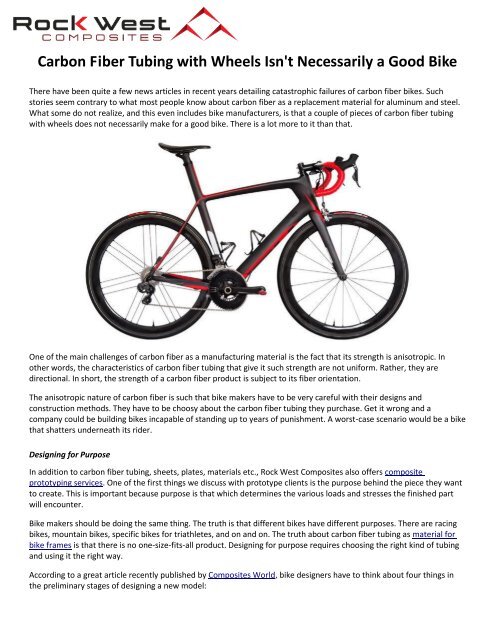Carbon Fiber Tubing with Wheels Isn't Necessarily a Good Bike
There have been quite a few news articles in recent years detailing catastrophic failures of carbon fiber bikes. Such stories seem contrary to what most people know about carbon fiber as a replacement material for aluminum and steel. What some do not realize, and this even includes bike manufacturers, is that a couple of pieces of carbon fiber tubing with wheels does not necessarily make for a good bike. There is a lot more to it than that. Visit: https://www.rockwestcomposites.com/custom/development/prototypes
There have been quite a few news articles in recent years detailing catastrophic failures of carbon fiber bikes. Such stories seem contrary to what most people know about carbon fiber as a replacement material for aluminum and steel. What some do not realize, and this even includes bike manufacturers, is that a couple of pieces of carbon fiber tubing with wheels does not necessarily make for a good bike. There is a lot more to it than that. Visit: https://www.rockwestcomposites.com/custom/development/prototypes
Create successful ePaper yourself
Turn your PDF publications into a flip-book with our unique Google optimized e-Paper software.
<strong>Carbon</strong> <strong>Fiber</strong> <strong>Tubing</strong> <strong>with</strong> <strong>Wheels</strong> <strong>Isn't</strong> <strong>Necessarily</strong> a <strong>Good</strong> <strong>Bike</strong><br />
There have been quite a few news articles in recent years detailing catastrophic failures of carbon fiber bikes. Such<br />
stories seem contrary to what most people know about carbon fiber as a replacement material for aluminum and steel.<br />
What some do not realize, and this even includes bike manufacturers, is that a couple of pieces of carbon fiber tubing<br />
<strong>with</strong> wheels does not necessarily make for a good bike. There is a lot more to it than that.<br />
One of the main challenges of carbon fiber as a manufacturing material is the fact that its strength is anisotropic. In<br />
other words, the characteristics of carbon fiber tubing that give it such strength are not uniform. Rather, they are<br />
directional. In short, the strength of a carbon fiber product is subject to its fiber orientation.<br />
The anisotropic nature of carbon fiber is such that bike makers have to be very careful <strong>with</strong> their designs and<br />
construction methods. They have to be choosy about the carbon fiber tubing they purchase. Get it wrong and a<br />
company could be building bikes incapable of standing up to years of punishment. A worst-case scenario would be a bike<br />
that shatters underneath its rider.<br />
Designing for Purpose<br />
In addition to carbon fiber tubing, sheets, plates, materials etc., Rock West Composites also offers composite<br />
prototyping services. One of the first things we discuss <strong>with</strong> prototype clients is the purpose behind the piece they want<br />
to create. This is important because purpose is that which determines the various loads and stresses the finished part<br />
will encounter.<br />
<strong>Bike</strong> makers should be doing the same thing. The truth is that different bikes have different purposes. There are racing<br />
bikes, mountain bikes, specific bikes for triathletes, and on and on. The truth about carbon fiber tubing as material for<br />
bike frames is that there is no one-size-fits-all product. Designing for purpose requires choosing the right kind of tubing<br />
and using it the right way.<br />
According to a great article recently published by Composites World, bike designers have to think about four things in<br />
the preliminary stages of designing a new model:
Weight – One of the main purposes for using carbon fiber instead of aluminum is to reduce the weight of the<br />
bike. Designers have to consider how light they want a new bike to be.<br />
Stiffness – The stiffness of a bike will determine how much energy its frame will be able to handle during a<br />
typical ride. Stiffness affects everything from the overall strength of the bike to the amount of work the rider has<br />
to put into peddling it.<br />
Safety – It should be the goal of every bike maker to ensure that every bike that rolls out of its factory is safe. The<br />
purpose of a given model is critical here. <strong>Bike</strong>s have to be designed to <strong>with</strong>stand purpose-determined loads and<br />
stresses <strong>with</strong> very little risk of catastrophic failure.<br />
Cost – Designers have to think of the full range of costs associated <strong>with</strong> building and selling a new model. Those<br />
costs cover everything from prototyping to large-scale manufacturing.<br />
Anybody can purchase carbon fiber tubing from Rock West Composites, cut it into sections, and create a bike frame out<br />
of it. They can attach it to wheels, a handlebar, and a seat before riding off into the sunset. But there are no guarantees<br />
that the bike will make it to the end of the street.<br />
<strong>Bike</strong> makers owe it to their customers to create safe and sturdy bikes. Doing so starts <strong>with</strong> an understanding of<br />
composite materials and their individual strengths and weaknesses.


